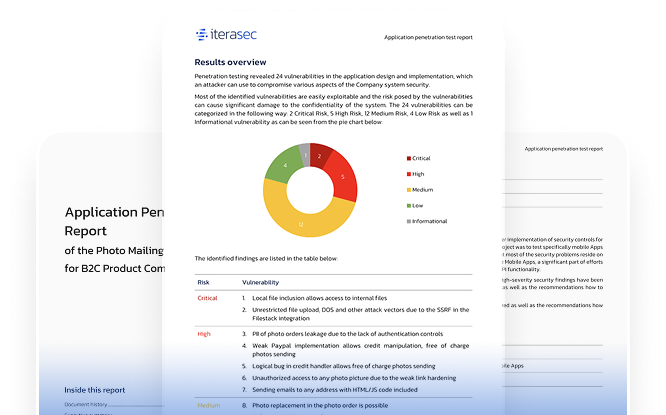Why Web Application Penetration Testing Services are Important for Your Web App
In the digital era, the security of web applications is a significant concern. Every web app is a potential target for attackers looking to exploit vulnerabilities for malicious purposes. Our web application penetration testing services are crucial for detecting and mitigating these threats, ensuring that your application remains secure and reliable for your users.
What Our Web Application Penetration Testing Services Can Detect
We focus on identifying complex vulnerability chains, thus offering protection against sophisticated cyberattacks. Our web application security testing company will help to identify the following vulnerabilities:
Complex business logic
Complex business logic vulnerabilities arise from improper implementation of application functionality, which can be exploited to bypass intended workflows or access controls. These flaws often require a deep understanding of the application's processes and can lead to unauthorized actions or data exposure.
Authentication weaknesses
Authentication weaknesses involve flaws in verifying user identities, allowing attackers to impersonate legitimate users. Common issues include weak password policies, improper session handling, and vulnerabilities in multi-factor authentication processes, directly threatening user accounts and sensitive data.
Compromised access controls
Compromised access controls fail to properly restrict user actions based on their roles, leading to unauthorized data access or modification. This category includes issues like privilege escalation, where users gain higher permissions than allocated, significantly impacting data integrity and privacy.
Flawed session management
Flawed session management can allow attackers to hijack user sessions or perform actions without proper authentication. Vulnerabilities include inadequate session expiration, insecure token storage, and susceptibility to session fixation attacks, compromising user identity and session security.
Security configuration errors
Security configuration errors derive from incorrect system settings or misconfigurations in security parameters, exposing applications to potential breaches. Common examples are exposed APIs, default credentials, and unsecured data storage options.
Errors in database interactions
Errors in database interactions, including improper sanitization and handling of user inputs, can lead to injection attacks and data leaks. These vulnerabilities allow attackers to execute unintended database commands, potentially accessing or corrupting sensitive information.
Cross-Site Scripting (XSS)
Cross-site scripting involves embedding malicious scripts into web pages viewed by other users. XSS attacks exploit user's trust in a particular site, allowing attackers to bypass access controls and steal information, such as cookies and session tokens.
DoS attacks
Denial of Service (DoS) attacks aim to make a resource unavailable to intended users by overwhelming the system with excessive requests. This vulnerability can damage application availability and effectiveness, leading to significant downtime and disruption.
Backend system defects
Backend system defects include unhandled errors and misconfigurations in server-side components that can be exploited to cause unexpected behavior or crashes. These defects may lead to severe security breaches if they provide attackers with control over backend systems.
Injection flaws
Injection flaws, such as SQL, NoSQL, or command injection, occur when untrusted data is sent to an interpreter as part of a command or query. Attackers can exploit these flaws to execute unintended commands or access unauthorized data.
API Security Flaws
API security flaws result from inadequate handling of API requests and responses, leading to data breaches, unauthorized data manipulation, or service disruptions. These vulnerabilities are critical in systems where APIs serve as primary interfaces for application interaction.
Exposure of Sensitive Data
Exposure of sensitive data occurs when data is stored or transmitted without proper encryption or protection measures, leading to potential data theft or leakage. Vulnerabilities in this category directly threaten user privacy and data security.
Our web application penetration testing services offer a holistic approach
Manual testing
At Iterasec, a leading pentesting company, our manual testing approach is designed to simulate real-world attackers, not just machines. Hence, effective pen testing is manual only to go beyond what scanners can find and simulate real adversaries.
Remediation
As part of our comprehensive web application security testing services, we provide support to fix the identified vulnerabilities properly. Free re-test included within three months after report delivery.
Solid report
Get a professional pentest report as part of our web app pentesting services with detailed finding descriptions and analysis of the work performed. On top of that, we provide an attestation letter you can show to your clients.
Not just pentesting
Pentesting is just the first step. We holistically help you build an efficient application security program and protect your infrastructure.
Why Penetration Testing with Iterasec?
Iterasec application pentesting services are distinguished by our:Expert Cybersecurity Team
Our team of security experts finds juicier and more complex security vulnerabilities than other vendors.
Pragmatic Approach
We start with threat modeling and tailor our testing methodologies to suit your specific application requirements.
Delivery Quality
On-time, clear communication, proactive. Underpromise, overdeliver – that’s our motto.

In reality, there are also some further “shades” or gray, if you are not sure which one is the most optimal for you, please contact our experts to advise you on the scope
Contact usOur Expert Cybersecurity Team
Cybersecurity is an industry of constant learning. Each of our colleagues has a professional and certification development plan.
Optimal approach to secure your business with professional Web Application Penetration Testing Services
Depending on the testing scope and input/data provided, web app pentesting services can be done in black, white or gray box mode.
Black box pentest
The client provides no or minimum input, such as IP address or company/domain name. While it simulates real-world scenarios, commercial pentests are still quite limited with the time-box.
Suitable for:
- attack simulation
- red teaming
Gray box pentest
The client provides information about the system, such as test credentials or even documentation. No source code is provided. In most of the cases, this is the most optimal type.
Suitable for:
- most of the pentests
White box pentest
Full information is provided, including source code, system documentation, etc. The big benefit is that due to code access, pentesters can reveal security issues from the inside.
Suitable for:
- product or application-level pentests
- codebase security review
Discover All Steps How Iterasec Pentesting Service works
During our pentests we rely on the NIST, OWASP, OSSTM, CIS Benchmark and other methodologies. While employing some automated tools, we mostly perform manual expert penetration testing: such an approach proves to be the most practically valuable.
We keep clients informed in the course of the project, providing regular status updates and immediate notifications for critical findings.
- 1A kick-off meeting to agree on the scope, inputs and communication
- 2Cloud pentest (2-5 weeks, depending on the scope)
- 3The final report that highlights the identified cloud security issues

Explore our sample penetration testing service report
Please contact us, and we will send you a sample pentest report covering several applications.
Contact usWhat our clients say
Awards and Recognitions
2023
Top cybersecurity consulting company
2023
Top cybersecurity consulting company
2023
Top ponetration testing company
Related Cyber Security Services
FAQs
Web application penetration testing is a specialized service provided by web application security testing companies to identify and mitigate potential vulnerabilities. This testing simulates real-world attacks on web applications to evaluate their security and uncover exploitable weaknesses, ensuring proactive risk management.
The duration of a web application security test varies based on the application’s complexity, size, and specific testing requirements. The exact timeline can be determined by consulting with a web application pentest services provider.
The cost of a web application penetration test depends on the test’s scope, the application’s complexity, and other details of the project. Contact us for a customized quote based on your specific needs.
At Iterasec, our web application penetration testing services are designed to meet the specific needs and environment of each application. We use a variety of advanced security instruments, including a mix of industry-standard tools and custom solutions tailored to the project’s unique requirements.
Contacts
Please tell us what are you looking for and we will happily support you in that. Feel free to use our contact form or contact us directly.
Thank you for submission!
We’ve received your request and will get back to you shortly. If you have any urgent questions, feel free to contact us at [email protected]



